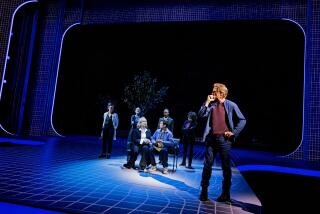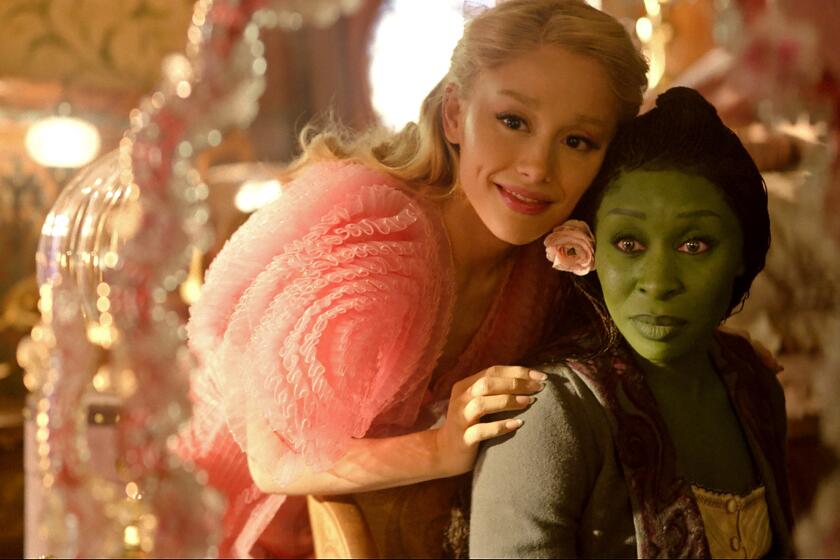Bitten by theater ‘Bug’
It’s a Sunday afternoon at Sunset and Gardner. Upstairs at Toi Thai, patrons sample crispy honey duck. Downstairs at the Gardner Stages’ rehearsal room, roughly the size of a parking space, an argument escalates until a recent parolee slams a fist into his ex-wife’s face, then exits with an offhand “I love you.” Peter, a Gulf War vet, walks in and shows a little tenderness to the bruised Agnes. A connection is made. The scene manages to be disturbing and intimate at the same time, the ugly debris of one love story building the possibility of another.
Director Scott Cummins turns to Andrew Hawkes, who plays the parolee. “Do we need another color here? Let’s play it a couple of times where you really do love her,” he says. “Just to hear it.”
Hawkes nods, taking the note.
Cummins and his Lost Angels ensemble are starting a run-through of the West Coast premiere of Tracy Letts’ “Bug,” which opened this weekend at the Coast Playhouse in West Hollywood. First produced in London, the play ran for nearly a year off-Broadway, winning Lucille Lortel and Obie awards, as well as the attention of William Friedkin, whose film version of the play will open while this production is still on the boards.
The story is deceptively simple: In a cheap motel room outside of Oklahoma City, 44-year-old Agnes (Amy Landecker) keeps the door locked and herself high, trying to avoid her violent ex-husband and painful memories of her son, who vanished from a grocery-store cart a decade before. When her friend R.C. turns up, trailing the strange, sweet Peter (Andrew Elvis Miller), Agnes falls hard and fast, daring to feel safe again. But Peter is carrying something more than the need to connect.
What distinguishes “Bug” from other Sam Shepard-style, small-cast plays about people at the extreme end of themselves is the operatic scale of its events and emotions. Letts’ story features self-administered dentistry, the consumption of illegal substances, staple gun assaults, nefarious government experiments, full frontal nudity and maybe -- depending on whether you believe Peter or not -- an infestation of killer aphids. But “Bug” is also a love story, or at least a story that asks if true love is possible after people have been turned inside out by life. Think Romeo and Juliet, high on blow, holed up in Area 51.
Directing “Bug” is the theatrical equivalent of performing open heart surgery during an Iggy Pop concert. You want someone with steady hands.
“Scott allows you to go in and out of the dark stuff,” Landecker says. “The most unusual thing about Scott as a director is that he’s incredibly laid back and has a lot of trust and patience. He’s so good-natured, yet when he comes around to saying what he wants, he knows exactly what he’s doing. It allows a sane environment around an insane play.”
It’s true that talking with Cummins is like a huddle with the supportive coach of your local minor league baseball team, and it turns out that Cummins, Chicago born and raised, was a serious jock in high school. His first theater experience, he says, was “making out with a girl in ‘Grease’ my junior year.” In college (where he met Miller), he started out in engineering and switched to theater after seeing the national tour of David Mamet’s “Glengarry Glen Ross” with Peter Falk and Joe Mantegna. “Falk played Shelley, and I remember hearing those first words of the play: ‘John, John, John, John, John
Passion for theater
Cummins trained as an actor, working steadily in Chicago -- he played “Hamlet” by 30 and calls it “the most fun role in the world” -- and received certification as an actor-combatant. The stage combat skills, he says, “got me to the other side of the table.”
After moving west in 2003, Cummins had directed only one show in Los Angeles -- Ann Noble’s “The Pagans” -- before nabbing an Ovation Award for his direction of Letts’ “Killer Joe, also with Lost Angels. But true to his reputation, Cummins passes the accolades along to Letts. “I almost felt guilty about winning an award for ‘Killer Joe.’ Tracy’s playwriting is so right there, it’s like, ‘Insert Tab A into Slot B.’ ”
In “Bug,” he says, the hard part is how to calibrate the audience’s response to Peter, whose obsession with the killer bugs drives the action. “Part of the excitement of the piece is flip-flopping between thinking Peter is crazy and thinking he is a victim of his circumstances -- that he did really go through all the things he claims. We want to believe him, for Agnes’ sake. The interesting thing is that Peter’s an alpha dog disguised as a beta dog. He presents as a victim, but in many ways he’s not. I always think of scenes as a balance of status and power -- whose needs and wants are dominating? It’s not enough to say that a character has an objective, because how someone goes about getting their objective is based on their status.”
But the story rings true only if an actor “can actually play the given circumstances of the text,” he says. “They have to be able to inhabit the play. Some actors just come to the table with those skills. I like to pick really truthful actors.”
Everyone in the L.A. “Bug” cast has worked on a Letts play before, with the exception of Miller, a nervy downtown New York performer whose career started with Blue Man Group. “I’m used to pit bull theater, fighting your way to the stage. Scott works that way, and this production is a very physical piece. The bugs are consuming us as the play progresses. We’re scratching and swatting and digging them out of our skin.”
The anxiety driving “Bug” feels post-9/11, but Letts wrote the play in 1995 partly in response to the Oklahoma City bombing. “I was in London, working on a production of ‘Killer Joe’ when I heard the news,” he says. “At first I thought it was a joke. Terrorism in Oklahoma? Then we found out it had been done by an American. And I began to wonder how people get to this point, where they think that kind of action is going to solve something.”
A balancing act
Cummins acknowledges a few bad directorial decisions can turn material this charged into Jerry Springer. “I think that’s where productions get into trouble,” he says. “They want to comment on the action. If you’re going to go on this ride -- and it is a ride -- you have to care about these people.”
In the end, Cummins insists, “ ‘Bug’ is really Agnes’ story. Like the audience, she’s the one who goes on the journey of her doubts about Peter, until she completely gives in at the end. She wants love. She’s lonely. The whole play is a metaphor for the difficulty of relationships, condensed and heightened. Tracy is asking what prevents us from healthily or fully loving.”
But Letts asks the question at full volume, at a thriller’s pace, says Lost Angels Artistic Director Laura Niemi. “The most incredible experiences I’ve ever had in theater have been in smaller venues, where you see the actors sweat. ‘Bug’ has that same punk-rock sensibility. Whatever you think of it, you’re definitely going to feel something.”
*
‘Bug’
Where: Coast Playhouse, 8325 Santa Monica Blvd., West Hollywood
When: 8 p.m. Thursdays to Saturdays, 3 p.m. Sundays
Ends: June 3
Price: $34.95
Contact: (866) 811-4111
More to Read
The biggest entertainment stories
Get our big stories about Hollywood, film, television, music, arts, culture and more right in your inbox as soon as they publish.
You may occasionally receive promotional content from the Los Angeles Times.










